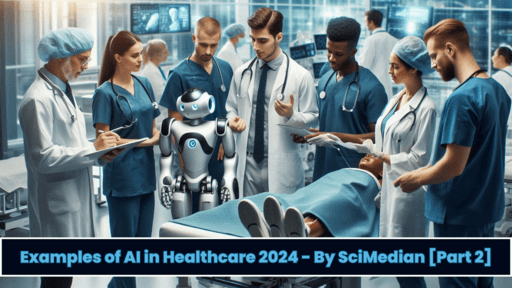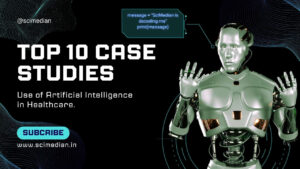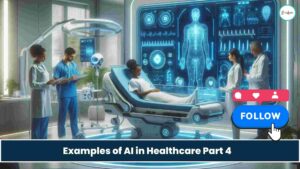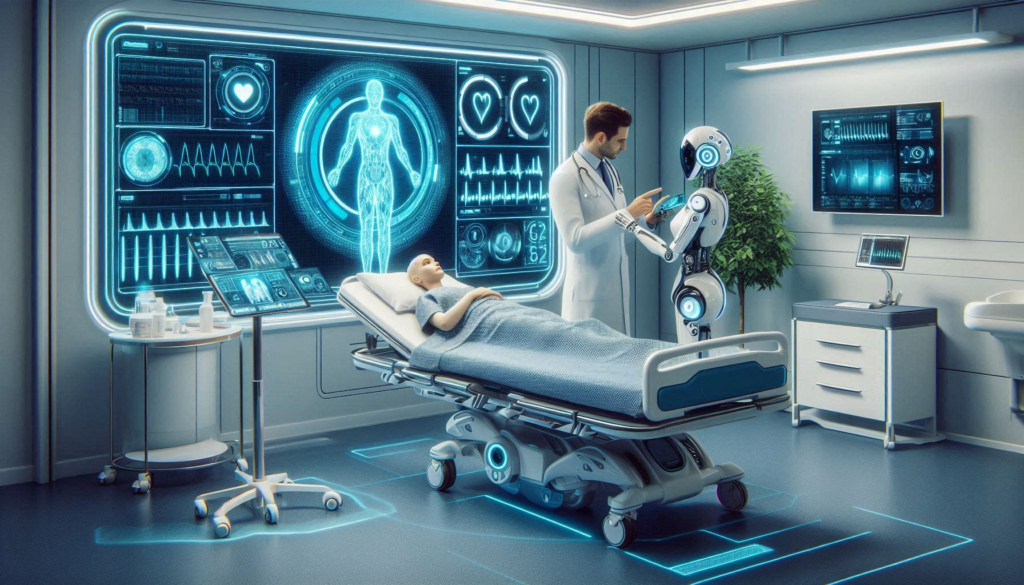Top 5 Examples of AI in Healthcare By SciMedian [Part 2]
Blog Introduction
Hello Experts, Welcome to SciMedian’s New blog. This is our second blog of this Series. The integration of (artificial intelligence) AI in healthcare is reshaping the medical landscape, offering unprecedented advancements in precision, efficiency, and patient care. This blog explores five transformative AI applications across various medical fields, showcasing their impact and potential. From the meticulous precision of robot-assisted surgeries to the robust security provided by AI-driven fraud detection and cybersecurity measures, we delve into the innovative ways AI is revolutionizing healthcare. Additionally, we highlight the rapid progress in AI-driven drug discovery, the predictive power of analytics in disease management, and the personalized treatment plans tailored to individual patient needs. Join us on this journey through the cutting-edge developments that are setting new standards in healthcare.

Robot Assisted Surgery: Advancing Precision and Patient Care
Robot-assisted surgery, also known as robotic surgery, combines the expertise of skilled surgeons with cutting-edge technology. Here are some common examples of procedures performed using robotic-assisted technology:
1. Appendectomy: Robotic systems assist in removing the appendix, minimizing incisions, and promoting faster recovery.
2. Colectomy: For conditions like colon cancer, robot-assisted colectomy allows precise removal of affected segments.
3. Gallbladder Removal: Robotic techniques enhance gallbladder surgery, reducing postoperative pain and scarring.
4. Gastric Bypass: In weight loss surgery, robots aid in creating a smaller stomach pouch and rerouting the digestive tract.
5. Hernia Repair: Robotic platforms facilitate hernia repair, ensuring accurate mesh placement and reduced recurrence risk.
6. Hysterectomy: For gynecological conditions, robot-assisted hysterectomy offers improved visualization and dexterity.
7. Mitral Valve Repair: Cardiac surgeons use robots to repair or replace heart valves, enhancing precision.
8. Pancreatectomy: In pancreatic surgery, robots assist in tumor removal while preserving healthy tissue.
Fraud Detection and Cybersecurity: Safeguarding Digital Assets
In our interconnected world, protecting sensitive information and financial transactions is paramount. Let’s explore how AI-driven fraud detection and cybersecurity measures play a crucial role:
1. Anomaly Detection:
- Credit Card Transactions: AI algorithms analyze spending patterns, flagging unusual transactions (e.g., large purchases in a foreign country) to prevent credit card fraud.
- Network Traffic: Intrusion detection systems (IDS) monitor network behavior, identifying abnormal data flows or unauthorized access attempts.
2. Behavioral Biometrics
- Keystroke Dynamics: AI learns individual typing patterns, recognizing when someone other than the account owner attempts to log in.
- Mouse Movements: Unusual mouse behavior can indicate fraudulent activity.
3. Machine Learning Models:
- Random Forests and Gradient Boosting: These models predict fraudulent behavior based on historical data, improving accuracy over time.
- Deep Learning: Neural networks analyze vast datasets, detecting subtle patterns indicative of cyber threats.
4. Phishing Detection:
- AI scans emails, identifying phishing attempts by analyzing sender behavior, content, and URLs.
- Natural Language Processing (NLP): NLP models recognize suspicious language or requests.
5. Blockchain Technology:
- Cryptocurrencies: Blockchain ensures secure, transparent transactions by preventing double-spending and unauthorized alterations.
- Smart Contracts: Self-executing contracts on the blockchain enhance trust and reduce fraud.
AI Driven Drug Discovery: Revolutionizing Medicine
The marriage of artificial intelligence (AI) and drug discovery holds immense promise for accelerating the development of life-saving treatments. Here are some remarkable examples of how AI is transforming the field:
1. Silicon Therapeutics:
This company employs a physics-driven approach to drug design. By leveraging first principles from physics, they predict whether a drug candidate exhibits biological effects. This method bypasses assumptions drawn from empirical chemistry and biology, leading to more accurate predictions.
2. Target Discovery and Validation:
AI-powered knowledge graphs help identify potential drug targets. These graphs integrate vast amounts of biological data, revealing hidden connections and enabling researchers to focus on promising pathways.
3. Generative Neural Networks:
Large pharmaceutical companies utilize generative neural networks for small-molecule design. These networks create novel chemical structures with desired properties, potentially yielding breakthrough drugs.
Predictive analytics in healthcare
Is a powerful tool that leverages data and algorithms to anticipate events and outcomes before they occur. Here are some real-world examples of how predictive analytics is transforming disease management:
1. Early Disease Identification:
- Diabetes Risk Assessment: Predictive analytics can identify individuals at high risk of developing diabetes by analyzing various factors such as age, family history, lifestyle choices, and biomarkers.
- Alzheimer’s Prediction: Deep learning algorithms predict Alzheimer’s disease up to six years before diagnosis with over 90% accuracy.
2. COVID-19 Patient Outcomes:
- Machine learning models forecast the intensity of sickness in COVID-19 patients, aiding timely interventions.
3. Reducing Hospital Readmissions:
- UnityPoint Health, a network of hospitals, clinics, and home care providers, reduced readmissions by 40% in 18 months using predictive analytics.
Personalized treatment plans
At the forefront of modern healthcare, tailoring interventions to individual patients based on their unique characteristics. Here are some examples of how personalized treatment plans are revolutionizing patient care:
1. Cancer Therapies:
- Precision Oncology: Genetic profiling helps identify specific mutations driving cancer growth. Targeted therapies, such as tyrosine kinase inhibitors, are then prescribed based on the patient’s genomic profile.
- Immunotherapies: Immune checkpoint inhibitors enhance the body’s immune response against cancer cells. These treatments vary based on tumor type and immune markers.
2. Cardiovascular Health:
- Statins and Lipid Management: Personalized dosing of statins considers cholesterol levels, genetic factors, and potential drug interactions.
- Antiplatelet Therapy: Patients with stents receive personalized antiplatelet drugs (e.g., clopidogrel or ticagrelor) based on their risk of clotting.
3. Mental Health:
- Antidepressants: Selection of antidepressants considers individual responses, side effects, and genetic variations.
- Psychotherapy Approaches: Therapists tailor cognitive-behavioral therapy (CBT) or other modalities to each patient’s needs.
4. Diabetes Management:
- Insulin Regimens: Personalized insulin dosing accounts for factors like lifestyle, meal patterns, and blood glucose fluctuations.
- Continuous Glucose Monitoring (CGM): CGMs provide real-time data, allowing adjustments to insulin therapy.
5. Autoimmune Diseases:
- Biologics: Patients with rheumatoid arthritis, psoriasis, or Crohn’s disease receive biologic therapies based on disease severity and individual response.
- Disease-Modifying Antirheumatic Drugs (DMARDs): DMARDs are tailored to the specific autoimmune condition.
Thank You









